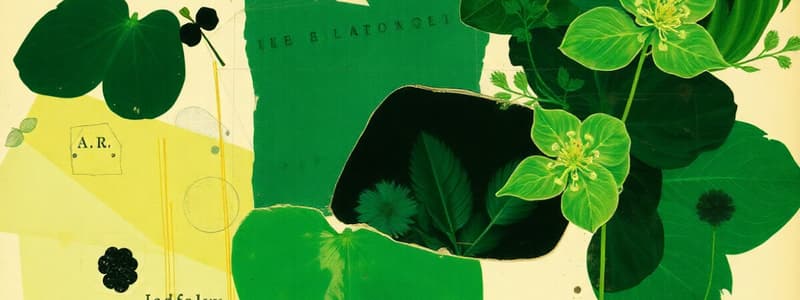Podcast
Questions and Answers
What are the primary pigments involved in photosynthesis?
What are the primary pigments involved in photosynthesis?
- Chlorophyll a and chlorophyll b (correct)
- Chlorophyll a and chlorophyll c
- Carotene and xanthophyll
- Chlorophyll a and carotene
What role do carotene and xanthophyll play in photosynthesis?
What role do carotene and xanthophyll play in photosynthesis?
- They transport electrons during photosynthetic reactions.
- They absorb light wavelengths not efficiently captured by chlorophyll a. (correct)
- They directly convert sunlight into energy.
- They initiate the Calvin cycle.
What is the basic structure of chlorophyll molecules?
What is the basic structure of chlorophyll molecules?
- A linear chain of amino acids.
- A complex ring structure with a central magnesium atom. (correct)
- A long hydrocarbon chain with a nitrogen base.
- Two small rings linked by a single bond.
What is the mechanism behind separating photosynthetic pigments?
What is the mechanism behind separating photosynthetic pigments?
How is the Rf value calculated in chromatography?
How is the Rf value calculated in chromatography?
What are the main light wavelengths absorbed by chlorophyll pigments?
What are the main light wavelengths absorbed by chlorophyll pigments?
What happens to light energy absorbed by chlorophyll a?
What happens to light energy absorbed by chlorophyll a?
What characteristic feature distinguishes carotene and xanthophyll from chlorophyll?
What characteristic feature distinguishes carotene and xanthophyll from chlorophyll?
What phenomenon allows pigments to absorb energy from light?
What phenomenon allows pigments to absorb energy from light?
Which pigment has a greater depth of color due to double bonds in its structure?
Which pigment has a greater depth of color due to double bonds in its structure?
What is the primary role of accessory pigments in the antenna complex of a photosystem?
What is the primary role of accessory pigments in the antenna complex of a photosystem?
Which photosystem is known for having a light absorption peak of 700 nm?
Which photosystem is known for having a light absorption peak of 700 nm?
In cyclic photophosphorylation, what happens to the electrons once they are excited?
In cyclic photophosphorylation, what happens to the electrons once they are excited?
What is the primary product of non-cyclic photophosphorylation?
What is the primary product of non-cyclic photophosphorylation?
Which wavelengths of light are most effective for photosynthesis according to the action spectrum?
Which wavelengths of light are most effective for photosynthesis according to the action spectrum?
Where do photosystems predominantly occur within the plant cells?
Where do photosystems predominantly occur within the plant cells?
Which term describes the process of ATP generation from the flow of protons through ATP synthase in the thylakoid membrane?
Which term describes the process of ATP generation from the flow of protons through ATP synthase in the thylakoid membrane?
What happens to the chlorophyll molecules in the reaction centre during photoactivation?
What happens to the chlorophyll molecules in the reaction centre during photoactivation?
What is the function of the electron carriers in the light-dependent reactions?
What is the function of the electron carriers in the light-dependent reactions?
What is a major difference between cyclic and non-cyclic photophosphorylation?
What is a major difference between cyclic and non-cyclic photophosphorylation?
Study Notes
Chlorophyll and Pigments
- Chlorophyll comprises different green pigments, primarily chlorophyll a (the key photosynthetic pigment) and chlorophyll b.
- These pigments absorb light most effectively in the blue (400-500 nm) and red (600-700 nm) wavelengths.
- The porphyrin ring structure, central to chlorophyll, contains a magnesium atom, resembling the 'haem' group in hemoglobin.
Accessory Pigments
- Carotene and xanthophyll are accessory pigments not directly involved in photosynthesis but assist by capturing light and transferring energy to chlorophyll a.
- Their structure consists of two rings connected by a long hydrocarbon chain, with color intensity varying by the number of double bonds present.
Chromatography Technique
- Chromatography separates photosynthetic pigments based on their solubility and molecular mass.
- A concentrated pigment spot on paper moves with a solvent, allowing identification through their characteristic Rf values (distance pigment travels/distance solvent front travels).
Absorption and Action Spectra
- Light is quantized, with photons representing individual light packets that contribute to photosynthesis.
- The efficiency of different light wavelengths reveals blue light (450 nm) and red light (650 nm) as the most effective for photosynthesis.
Photosystems
- Two types of photosystems are involved:
- Photosystem I (PSI) with a peak absorption at 700 nm (P700) located mainly on inter-granal lamellae.
- Photosystem II (PSII) with a peak absorption at 680 nm (P680) primarily on granal lamellae.
- Photosystems function as collections of chlorophyll a, accessory pigments, and proteins facilitating energy capture during photosynthesis.
Light Harvesting Mechanism
- Emerson and Arnold discovered that groups of chlorophyll molecules cooperatively capture light for photosynthesis.
- The "antenna complex" of accessory pigments absorbs photons, transferring energy to the reaction center (chlorophyll a) where electrons are excited.
Photoactivation of Chlorophyll
- Excited state electrons are transferred to electron carriers, undergoing redox reactions, losing energy, which helps pump protons across the thylakoid membrane.
- This proton gradient drives ATP production through chemiosmosis (photophosphorylation), combining ADP with inorganic phosphate.
Cyclic vs. Non-cyclic Photophosphorylation
- Cyclic Photophosphorylation:
- Involves PSI only, where excited electrons are recycled back to the same chlorophyll molecule, generating ATP without reducing NADP.
- Non-cyclic Photophosphorylation:
- Involves both PSI and PSII, with electrons from PSII replenishing those lost in PSI, culminating in NADP+ reduction and supporting light-independent reactions.
Studying That Suits You
Use AI to generate personalized quizzes and flashcards to suit your learning preferences.
Description
This quiz explores the various chlorophyll pigments, including chlorophyll a and b, and their functions in photosynthesis. Understand how these green pigments absorb light and the significance of the porphyrin ring structure. Test your knowledge about the biochemical processes that utilize chlorophyll.




